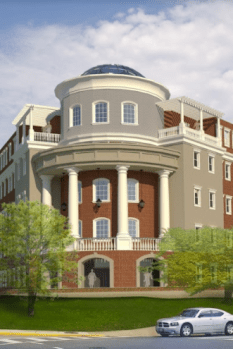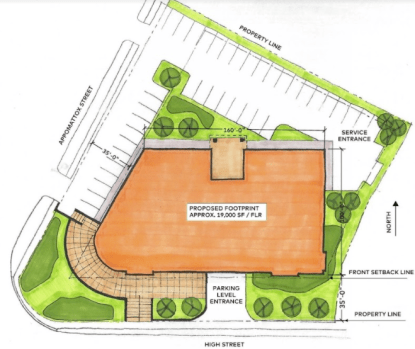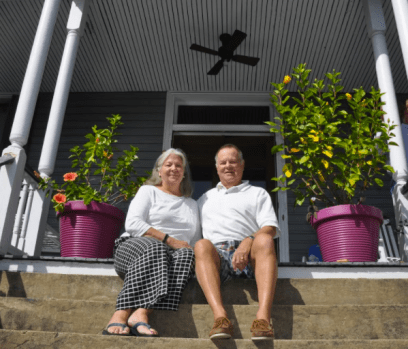‘It is no longer historic’ — Martins discuss controversial complex proposal
Published 7:38 pm Wednesday, September 20, 2017
Editor’s Note: On Tuesday, The Herald sat down with Robert and Sherry Martin, along with developer Mike Kelley and attorney/adviser Frank F. Rennie IV, to discuss the Martins’ rezoning request, along with the proposed 195-student complex planned for Farmville. This is one of two articles from that interview.
“We watched this neighborhood change, and years ago, we had a lot of neighbors,” Sherry Martin said, sitting in a room in the front of her house, which faces the intersection of High Street and Griffin Boulevard. “We’ve watched it change. So, we just decided to protect our property.”
Sherry is referring to a project being proposed by she and her husband, Robert — who’s also known as Bobby — that, if approved, would result in a five-story, 95,000-square-foot student apartment complex that would house up to 195 students.
The Martins are seeking to rezone their just more than an acre of property containing four houses they own at the intersection of High, Oak and Appomattox streets — where they sat during an interview with The Herald Tuesday, along with developer Mike Kelley and adviser and attorney Frank F. Rennie IV — from R-3 Residential to R-3A Residential. The request, along with and a separate request from Walk2Campus Holdings LLC President and CEO Matthew King to rezone 37 of his firm’s student housing properties to R-3A Residential, are set to be considered by the Farmville Planning Commission on Wednesday during its 7 p.m. meeting.
The Martins’ request includes repealing the density level maximum of 10 units per acre for the R-3A Zone to allow for the proposed complex. The R-3A Zone is the same that Longwood University’s main campus is classified as, and the zone Walk2Campus is seeking.
During a July planning commission meeting, 18 people voiced stern opposition to the rezoning requests, citing parking, quality-of-life issues, losing the historic feeling in the area, “bigger-city problems,” traffic congestion, the demand for student housing and precedent that could be set by the decisions.
“We wish this area was still historic,” Sherry said regarding the opposition the project has seen. “…This area wouldn’t be registered as historic if it hadn’t been for Bobby Martin. He and several historians in this area … they documented every single solitary house in this area. And they turned in, and I have it — the information in 1989. They went to the town council, they went to downtown (business owners and merchants), they went to the residents. They begged, they pleaded. Bobby was president of Historic Farmville for 10 years … We tried to keep it historic. It is no longer historic,” she reiterated, displaying a map of an area including Appomattox, High, Grove and Buffalo streets, depicting present student housing locations. “We’ve looked them all up. We’ve got quadruplexes, triplexes, we’ve got aluminum siding, we’ve got vinyl siding … It’s not historic anymore. It’s student housing. And it is student housing to the point of 350-450 students from a reliable source, let’s put it that way.”
“It would be nice if it was still historic,” Sherry said. “It isn’t.”
“We’ve talked about it for years,” she said of vacating their home at the intersection of Appomattox and High streets. “We have four children, and they grew up in this house,” she said. “…It’s just this house is big and we thought, you know, years ago, and we’ve been approached more than several times about doing something with this property. And we’ve said, ‘No, no, no.’ And quite frankly, this is not a derogatory statement about the roundabout, but that kind of pushed us to think where we were going with everything.”
She said a friend of hers and Bobby introduced them to Developer Mike Kelley of Kelley Properties, who said during the interview he wanted to “most definitely” look into relocating the home the Martins reside in instead of razing it.
“First and foremost is the property is so special, I’m talking about the house, if there was, and I don’t know anything about relocating houses at all … What I’ve always dreamed of doing is taking the house and have maybe the Farmville Chamber of Commerce, or something of that nature so the woodworking and the doors and the stairs (are preserved).”
Kelley said he wasn’t the “classic developer” who saw the Martins’ home as “in the way (and) knock it down. What I’d like to (do) is work with someone in the community to relocate the house so the integrity of the house that’s been here forever would stay as a compliment to the town, and I think that would be really special. …”
“We saw something that we wanted to leave a nice footprint,” Sherry said. “Bobby’s lived here all his life. We didn’t want to stick something up here, you know, just anything, or add on to this house and just make it a box. We wanted something really nice looking. And so Mike … wanted to help with that, and that’s where it came from.”
When the couple purchased the house 35 years ago, the Martins did “a tremendous amount of work” to improve the home, which Sherry said was divided into apartments at the time.
Their home, which offers a combination of Victorian and Federalist styles, was originally built in 1899 after 10 years of work.
“So, you can see it’s special,” Kelley said.
Citing the recent completion of a student housing project at Wake Forest in North Carolina, Kelley said “we sat down with Wake Forest, like we’ve done here with (Longwood President W.) Taylor (Reveley IV), and tried to view what was the best and highest use of the property near the campus, and knowing that Longwood themselves are getting ready to build … an admissions facility,” Kelly said.
“That’s coming,” Sherry said in reference to the building. “That’s another huge building that’s coming on this side of the street.”
According Longwood’s Master Plan, the planned 21,000-gross-square-foot admissions building will be at the intersection of St. George and Buffalo streets. A graphic on the university’s website depicts the building as standing two stories.
Kelley said keeping the students “under one roof” was important “rather than having them spread out currently as they are. There’s several hundred kids all within this area, and what we had to do at Wake Forest in the neighborhood, is come up with a building design that would be able to accommodate somewhere in that 200-range seems to be the number that most of the dorms (have). As you see, you go down Griffith (Boulevard), there’s the three dorms down the street, they’re about the same size.”
“To me it was important that we met with (Reveley) first because we … want the chemistry between the university and us to be almost one and the same. I think the biggest thing that we talk about … where Longwood has the benefit of this … is what they call the private-public partnering,” Kelley said, explaining the concept as colleges taking their endowment money and constructing more educational facilities “rather than residential facilities.”
Noting the apartments would have a “live-in manager,” Sherry said, “there is no live-in site manager in this area, quite frankly. Bobby and I are the resident managers.”
“From 2004 to 2012, over 50 houses were sold in this area for rental,” Sherry said. “Some of them were resold … Student rental is not easy … If you look at the whole thing, probably 60 sales have happened in an eight-year period. My question is, where were all these people who are so upset about (our project) , why weren’t they buying these houses? Quite frankly, several of them sold, that are against (our) project, sold to Walk2Campus or to one of these other people who are doing rental houses, and they’re now against this project, calling it historic. It’s not historic anymore. We’d stay here if it was. We tried to make it historic.”
Bobby said he formed a historic organization for Farmville and helped establish the existing historic district.
“We got it all straight, and then we sent it to town council to approve the study, to approve the architectural review board (ARB), and to send it in to the (state). The town never approved it … What they weren’t happy to do was put an ARB in place.”
This took place in the early 1990s, Sherry said.
Bobby called the historic district “positive. I mean, it’s a designated historical district without teeth.”
According to an application titled “National Register for Historic Resources” on the Virginia Department of Historic Resources’ website, the designation was made in 1989.
“It’s a district, and it’s designated historical but it’s not historical anymore,” Sherry said. “This part of Farmville changed while nobody was looking. And, literally, we were looking, a couple of other people were looking, nobody around town was looking. All of a sudden we’ve brought it to the forefront. …”








